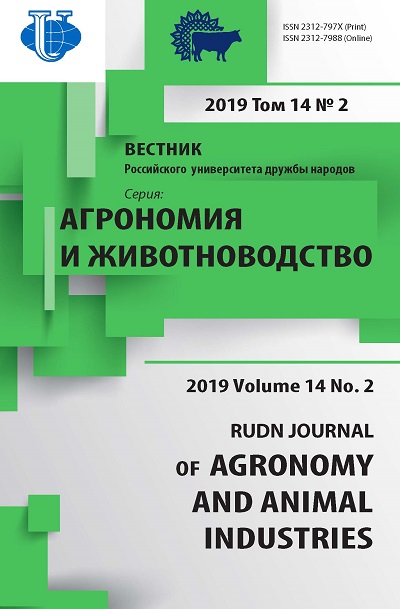Ecological functions of forest stands in urbanized environment of Moscow
- Authors: Dubenok N.N.1, Kuzmichev V.V.1, Lebedev A.V.1
-
Affiliations:
- Russian State Agrarian University - Moscow Timiryazev Agricultural Academy
- Issue: Vol 14, No 2 (2019)
- Pages: 154-161
- Section: Botany
- URL: https://agrojournal.rudn.ru/agronomy/article/view/19493
- DOI: https://doi.org/10.22363/2312-797X-2019-14-2-154-161
- ID: 19493
Cite item
Full Text
Abstract
In urban forests, stock production is not the main function of stands. Carbon sequestration, the release of oxygen and phytoncides, dust precipitation, and changing wind conditions et al. are the main environmental functions. Phyto-organic substances emitted by trees help to reduce the number of microorganisms in air make the air cleaner and fresher. The purpose of the study is to evaluate the ecological functions of forest stands based on long-term observations of the forest stands of the Forest Experimental District of the Russian State Agrarian University - Moscow Timiryazev Agricultural Academy. The study used data about 7 permanent trial plots in natural pine stands, 7 - in pine plantations (planting density - 32 000 trees per 1 ha), 13 - in larch plantations (planting density - 700-4000 trees per 1 ha), 8 - in oak stands (natural stands and plantations) and 9 - in birch stands (natural stands and plantations). For a year, 1 ha of forest covered area produces 10 tons of oxygen, and the entire territory of the Forest Experimental District produces about 2.5 thousand tons of oxygen. In the year, the stands of the Forest Experimental District absorb about 3 thousand tons of carbon dioxide. The forest stands of the Forest Experimental District are capable of precipitating 135 tons of dust and they emit about 130 tons of phytoncides into the air during the growing season. Under urban conditions, forest stands are subject to the influence of negative factors: emissions from industrial enterprises and transport, recreational loads, disruption of natural conditions, and many others. Negative factors lead to a decrease in the performance of ecological functions. Therefore, in urban forests it is necessary to carry out silvicultural measures to increase the sustainability and productivity of stands.
About the authors
Nikolay Nikolaevich Dubenok
Russian State Agrarian University - Moscow Timiryazev Agricultural Academy
Author for correspondence.
Email: ndubenok@mail.ru
Academician of the Russian Academy of Sciences, Professor, Doctor of Sciences in Agriculture, Head of the Department of Agricultural Land Reclamation, Forestry and Land Management
Moscow, Russian FederationValeriy Vasilyevich Kuzmichev
Russian State Agrarian University - Moscow Timiryazev Agricultural Academy
Email: kuzmichev33valery@mail.ru
Professor, Doctor of Sciences in Biology, Senior Researcher at ‘Forest Experimental Dacha’
Moscow, Russian FederationAlexandr Vyacheslavovich Lebedev
Russian State Agrarian University - Moscow Timiryazev Agricultural Academy
Email: mail@lebedev.fun
postgraduate student, of Agricultural Land Reclamation, Forestry and Land Management
Moscow, Russian FederationReferences
- Bogachev AV. Forest Taxation Researches. Moscow: VNIILM Publ.; 2007. (In Russ).
- Dubenok NN, Kuzmichev VV, Lebedev AV. Analysis of ecological functions of birch and oak stands in the conditions of an urbanized environment based on the materials of long-term observations. Russian Agricultural Sciences. 2018; (5): 29-31. Available from: doi: 10.3103/S1068367418060046 (In Russ).
- Dubenok NN, Kuzmichev VV, Lebedev AV. Growth and productivity of pine and larch stands under conditions of urban environment. Vestnik of Volga State University of Technology. Series: Forest. Ecology. Nature. 2018; (1):54-71. Available from: doi: 10.15350/2306-2827.2018.1.54 (In Russ).
- Kuzmichev VV. Regularities of stand growth. Novosibirsk: Nauka Publ.; 1977. (In Russ).
- Rogozin MV, Razin GS. Models of dynamics and modeling of tree stand development. Siberian Forest Journal. 2015; (2):55-70. (In Russ).
- Liepa IY. Dynamics of wood stock: Forecasting and ecology. Riga: Zinatne Publ.; 1980. (In Russ).
- Utkin AI, Ermolova LS, Utkina IA. Surface area of forest plants: essence, parameters, use. Moscow: Nauka Publ.; 2008. (In Russ).
- Kretinin VM, Selyanina ZM. Retention of dust by the leaves of trees and shrubs and its accumulation in light chestnut soils under the forest belts. Soil science. 2006; (3):373-377. (In Russ).
- Ioffe AO. Determination of the level of dust in the territory of Petrozavodsk. Basic research. 2014; (6-4): 753-759. (In Russ).
- Artyuhovsky AK. Sanitary hygienic and medicinal properties of forest. Voronezh: VGU Publ.; 1985. (In Russ).
Supplementary files















